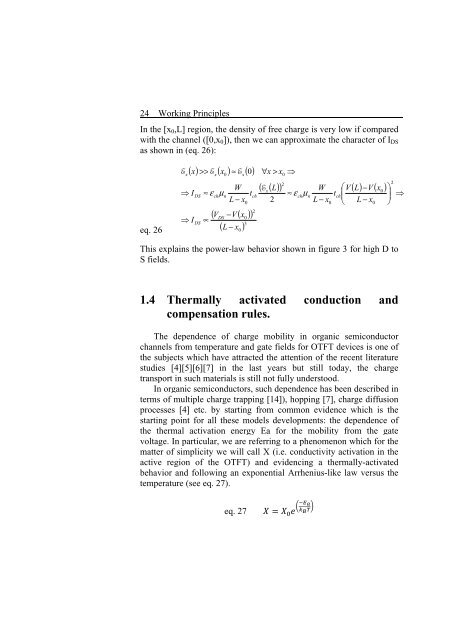tesi R. Miscioscia.pdf - EleA@UniSA
tesi R. Miscioscia.pdf - EleA@UniSA
tesi R. Miscioscia.pdf - EleA@UniSA
You also want an ePaper? Increase the reach of your titles
YUMPU automatically turns print PDFs into web optimized ePapers that Google loves.
24 Working Principles<br />
In the [x0,L] region, the density of free charge is very low if compared<br />
with the channel ([0,x0]), then we can approximate the character of IDS<br />
as shown in (eq. 26):<br />
eq. 26<br />
E<br />
x<br />
( x)<br />
>> E ( x ) ≈E<br />
( 0)<br />
⇒ I<br />
⇒ I<br />
DS<br />
DS<br />
∝<br />
x<br />
0<br />
W<br />
≈ ε chμn<br />
t<br />
L − x<br />
( ( ) )<br />
( ) 3<br />
VDS<br />
−V<br />
x0<br />
L − x<br />
0<br />
x<br />
0<br />
ch<br />
2<br />
∀x<br />
> x ⇒<br />
2 ( E ( L)<br />
) W ⎛V<br />
( L)<br />
−V<br />
( x )<br />
x<br />
This explains the power-law behavior shown in figure 3 for high D to<br />
S fields.<br />
1.4 Thermally activated conduction and<br />
compensation rules.<br />
The dependence of charge mobility in organic semiconductor<br />
channels from temperature and gate fields for OTFT devices is one of<br />
the subjects which have attracted the attention of the recent literature<br />
studies [4][5][6][7] in the last years but still today, the charge<br />
transport in such materials is still not fully understood.<br />
In organic semiconductors, such dependence has been described in<br />
terms of multiple charge trapping [14]), hopping [7], charge diffusion<br />
processes [4] etc. by starting from common evidence which is the<br />
starting point for all these models developments: the dependence of<br />
the thermal activation energy Ea for the mobility from the gate<br />
voltage. In particular, we are referring to a phenomenon which for the<br />
matter of simplicity we will call X (i.e. conductivity activation in the<br />
active region of the OTFT) and evidencing a thermally-activated<br />
behavior and following an exponential Arrhenius-like law versus the<br />
temperature (see eq. 27).<br />
eq. 27 <br />
<br />
2<br />
0<br />
≈ ε chμn<br />
t<br />
L − x<br />
0<br />
ch<br />
⎜<br />
⎝<br />
L − x<br />
0<br />
0<br />
⎞<br />
⎟<br />
⎠<br />
2<br />
⇒
















